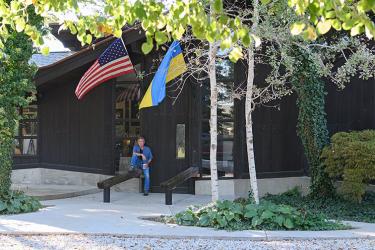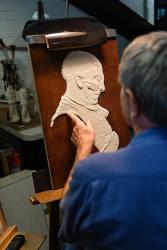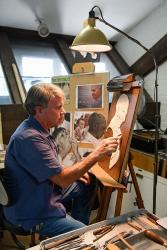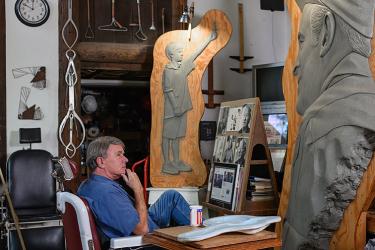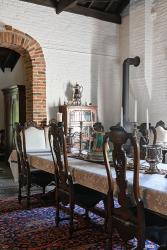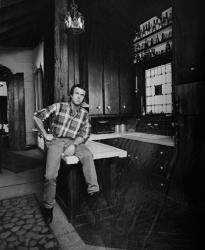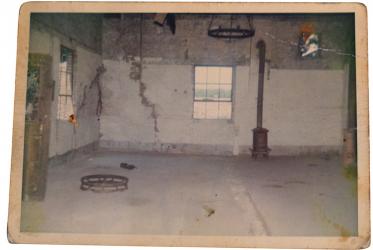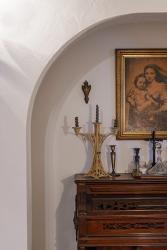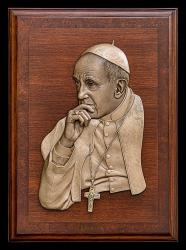Known worldwide for his memorable sculptures of renowned historical figures, Don Wiegand has built a life and career around art. He’s created casts of all sizes and various subjects including Charles Lindbergh, Amelia Earhart, Mark Twain and the Pope. But perhaps his biggest sculpture yet has been the transformation of a 1920s era building that is now headquarters to the Wiegand Foundation and his studio. Calling it a “functional” sculpture, Wiegand has spent decades transforming the rundown slaughterhouse into an amazing display of his award-winning work and treasured collection.
Creating art has been in Wiegand’s blood since he was born. Starting all the way back at the age of 3, he would craft creations using cardboard, paper and other random materials from around the house. In 1952, when Don was five years old, his family moved to Chesterfield and his parents purchased the Smokehouse Market and slaughterhouse properties. As his interest in art grew, he realized that a space to create his art was important, so he set up a studio on the third floor of the Smokehouse where he would sketch portraits and make wax models.
In 1965, when he was a junior in high school, Wiegand and two friends were tasked with boarding up the unused slaughterhouse. His friend suggested he fix up the space and turn it into a studio for his art. “I thought he was crazy!” Wiegand laughs. “The place was a mess,” but as time went on, Don quickly realized he needed to make this space his own.
The job was not an easy one as the roof was caved in and the building was close to being condemned, but Wiegand persisted. “This was going to be a space for working, living, showing and gathering,” he says of his vision for the studio. “I was going to build a place no one could put a price on.”
Wiegand spent much of the next several years restoring and expanding the slaughterhouse. The roof was raised, a fireplace added and a floor was poured. He also installed and wired a stereo system, which he built into a hidden bookcase. As a teenager with little money to work with, he had to be creative with the materials for the renovation using mostly scrap or recycled items like glass, brick and windows. “I was doing ‘green’ before it was a thing,” he says.
In 1967, he knew he needed to expand and design the building all the way around the property adding an atrium/greenhouse, bathroom, kitchen and studio for his sculpture work. It was important for the building to be interesting from all angles—a philosophy that is also important in the sculptural process. “I decided to treat the building as a sculpture,” he explains. “Interesting from all angles but also functional.” Wiegand has furnished and adorned the studio with treasures and objects he has collected through the years from family, friends and colleagues. Every item reflects a special memory, and Wiegand can tell you the history and significance of almost 90 percent of the treasures in his studio.
Despite pouring his blood, sweat and tears into his studio space, Wiegand has faced countless heartbreaking challenges along his journey. On Christmas Eve in 1971 the place caught fire after his brother and cousin were making candles in the kitchen. The building suffered significant smoke and fire damage, but Don persevered and vowed to rebuild. “The restoration process taught me to antique wood, which is a technique I now use in my sculptures,” he explains. The space took years to get it back to what it had been.
Then the great flood of 1993 threatened to take the building with water all the way to the chandelier level. Yet again, Don persevered and made the studio more flood resistant and stable. “In my gut, I knew I was supposed to continue on with this building and that kept driving me through all of the tribulations,” Wiegand says.
Surviving both fire and flood, his challenges were not done yet. In 2009, the U.S. Army Corps of Engineers attempted to condemn the property as part of their effort to build a levee wall along the creek adjacent to the studio. After a long battle, Wiegand and the Corps reached an agreement to allow the property to remain. Financial struggles plagued the property in 2014, and the building was seized by the bank for five years before the Wiegand Foundation, which was established in 2004 to preserve the art and legacy of Don F. Wiegand, was able to raise enough money to buy back the property.
Through every misfortune, Wiegand has always persevered. “Sometimes trials in life are blessings you don’t see,” he says. “Roses grow in manure.” Instead of giving up in the face of adversity, Wiegand chose to see the positive in each situation saying if he hadn’t gone through each trial he wouldn’t have been able to make it through the next harder one.
Today, Wiegand continues to bring his life-size portraits to life in his studio. He recently returned from the Vatican where his bas-relief sculpture of Pope Francis was chosen by the Pontifical Academy of Sciences in special recognition of its efforts to help build a sustainable world. Wiegand presented the sculpture to Pope Francis in September and the sculpture is exhibited in the historic 16th century Casina Pio IV, home of the Academy.
His studio has evolved into more than a place for him to hone his craft. Wiegand calls his functional sculpture his biggest passion and greatest accomplishment in life. “This building has not only allowed me to create sculptural pieces, but also to share those with everyone,” he says. “To see people’s awe at what I have created is the reason I have kept doing this all these years.”
To date, the Wiegand Foundation has hosted over 300 organizations on location to raise funds and recognize important donors. “My legacy is to honor those who are working hard to preserve life. I use this property and my art to honor those making a difference,” he says, humbly. “We are all custodians of the moment, and I have never felt like I owned any of this. I am simply the caretaker.”


